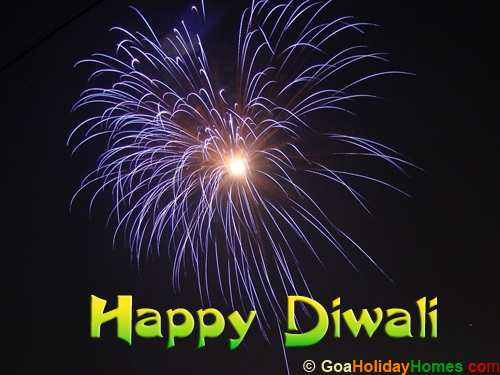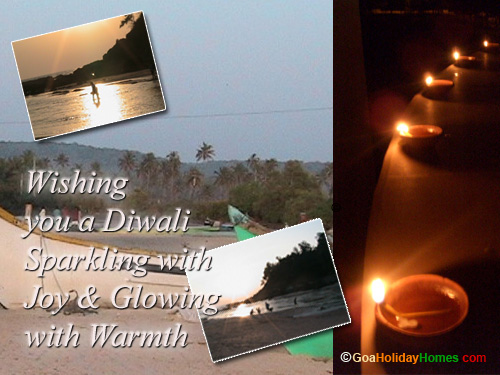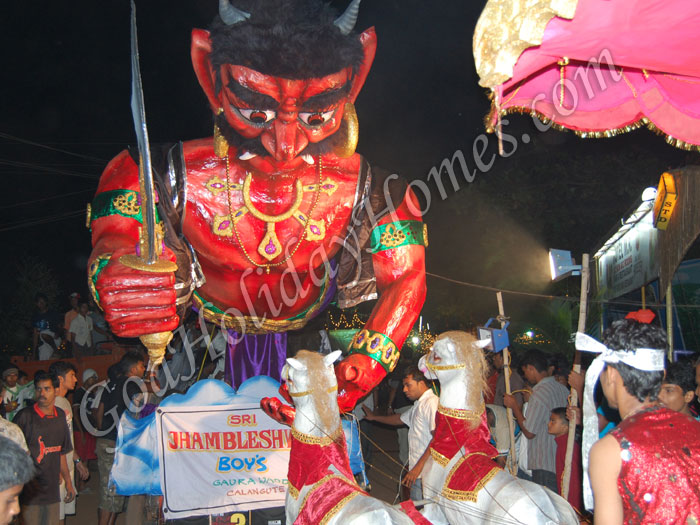Diwali in Goa
The festival marks the victory of good over evil. The Sanskrit word Deepavali means array of lights that stands for victory of brightness over darkness. As the knowledge of Sanskrit diminished, the name was popularly modified to Diwali, especially in northern India.
Click here to send a Diwali greeting card to someone.
On the day of Diwali, many wear new clothes, share sweets and light firecrackers. The North Indian business community usually starts their financial new year on Diwali and new account books are opened on this day.
Hindus find cause to celebrate this festival for different reasons:
As per sacred texts, according to Skanda Purana, the goddess Shakti observed 21 days of austerity starting from ashtami of shukla paksha (waxing period of moon) to get half part of the body of Lord Shiva. This vrata is known as kedhara vrata. Deepavali is the completion day of this austerity. This is the day Lord Shiva accepted Shakti into the left half of the form and appeared as Ardhanarishvara. The ardent devotees observe this 21 days vrata by making a kalasha with 21 threads on it and 21 types of offerings for 35 days. The final day is celebrated as kedhara gauri vrata.
Children lighting lamps in the form of swastika on eve of diwaliDiwali also celebrates the return of Lord Rama, King of Ayodhya, with his wife Sita and brother Lakshmana to Ayodhya from a war in which he killed the demon king Ravana. It is believed that the people lit oil lamps along the way to light their path in the darkness. In North India, the festival is held on the final day of the Vikram calendar. The following day marks the beginning of the North Indian new year, and is called Annakut.
It commemorates the killing of Narakasura, an evil demon who created havoc, by Lord Krishna's wife Sathyabhama. This happened in the Dwapara Yuga during this time of Lord Krishna's avatar. In another version, the demon was killed by Lord Krishna himself. In South India, Diwali does not coincide with the beginning of a new year as South Indians follow a different calendar, the Shalivahana calendar.
In Bhavishyottara and Bramhavaivarta Purana, Diwali is associated with the Daitya king Bali, who is allowed to return to earth once a year.
Diwali which is the festival of lights, is a one-day festival in Goa. Bhaubija and the New year day are also celebrated as part of Diwali festival. In Goa, huge effigies of Narkasura the demon, are made and burnt at dawn. The night of Diwali is also be jeweled with millions of flickering candles and an explosion of fire works and fire crackers, so it is known as the Festival of Lights. The lamps signify enlightenment or upliftment of the mind and edification of the spirit.
According to legend Narkasur was a Rakshas (demon) who was terrorizing the people. He used to come down to the villages and capture and kill the citizens. Lord Krishna killed him and freed people from his terrorism. Till this time there was no peace because of the people's fear of the Narkasur. With his killing, people were in a celebratory mood. They lit up their houses with 'pontis' and hung 'akash divas' above their houses.
Narak Chaturdasi is called Diwali in Goa. On this day, early morning, a paper made Narkasur (demon) filled with grass, wastepaper, crackers etc is taken out and to the accompaniment of taunts and insults, burnt and cremated. Early on Diwali day after burning the Narkasur the Hindu menfolk will return to their homes to be massaged by their wives / mothers with the same type oil and 'utnem'. The family then visits the local temple and returns to a similar feast of 'foav' sweets.
Contact Details
Address:



